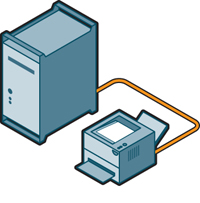
Most of your time is no doubt focused on keeping your business moving forward, hiring and managing people, and servicing your customers. And there’s never enough time for keeping track of your competition and for your own strategic planning.
“When so much of your attention is devoted to operating your business, it can be difficult to know when you’ve reached the point to implement an automated order management system,” says Ernie Schell, director of Ventnor, NJ-based systems consultancy Marketing Systems Analysis.
Most start-ups do fine getting off the ground using either a manual, homegrown order processing and fulfillment solution or an accounting package, Schell says. “As business volumes pick up, most find those same in-place systems are not growing with — and may be hindering — operations.”
Below are five signs it may be time to consider an automated OMS.
- Too many mistakes in data entry, shipping, purchasing, invoicing and accounting
Errors are costly — from mistakes typing addresses or credit card numbers, to misordering stock, to packing the wrong merchandise or shipping to the wrong customer. As a company grows in size, revenue or SKU count, its complexity increases, and so do the chances for mistakes.
- Payroll costs are on the rise
Is your payroll heading higher because your solution to handling an increase in sales is to hire more staff or pay for overtime? More sales usually leads to more revenue, but an OMS might be a more cost-effective option for managing growth.
Compare the cost of an OMS designed and priced for your size company vs. all those additional payroll costs. An OMS may be less expensive — and it may end up being a good investment.
- Trouble keeping up with demand
Timeliness is essential for order processing and good customer service. How long does it take to process an order? How long does it take to respond to a customer inquiry about his order? Are employees spending more time chasing down information about fulfilled orders than handling new ones?
As order volume grew at GPSDiscount.com, Scott Farris found he was spending more and more time just trying to keep up with demand for the site’s GPS devices.
“The sales volume got to a point where we didn’t have enough man hours to handle the day’s orders,” he says. GPSDiscount.com implemented an OMS from Stone Edge in 2000. Now the time to process orders “is a fraction of what it was before we automated,” Farris says.
- Too many inventory surprises
Running out of stock or, worse yet, not knowing you are out of stock, can lead to lost revenue. But purchasing too much merchandise ties up funds and risks losing money on unsold merchandise. A merchant needs full visibility into stock levels plus a view on SKU history to track sales trends.
Kate’s Caring Gifts carries seasonal chocolates. “In past years,” says cofounder Lee Amon, “we tried to remember how many we had ordered the prior year and guessed.” The company installed an OMS in 2006. Now it looks at last year’s shipping history to know exactly how many of each type it sold last year.
- Fear of success
How would your current order processing method perform if demand for your products suddenly exploded? Kate’s Caring Gifts learned how important its OMS was one Dec. 15, when an episode of TV talk show The View mentioned a Kate’s item.
“The response was overwhelming,” Amon says. “By Dec. 18 we had 600 orders — our average had been about 20 orders a day.” It could not have handled the unexpected business without an OMS, Amon says.
Is an OMS right for you? You have to weigh all the options. But being realistic about when you need to invest in technology can be critical to the health and profitability of your business. And in this economy, you need to focus on the investments that can save you time and manpower.
Rebecca Barthel is a senior consultant with Next Step, a consulting and training firm.
Order Management Systems
AUTOMATE THE TYPICAL TASKS INVOLVED IN RECEIVING AND FULFILLING SALES ORDERS. WHILE THE SPECIFIC RANGE OF FUNCTIONS EACH VENDOR’S SYSTEM PROVIDES WILL VARY, MOST ORDER MANAGEMENT SYSTEMS HANDLE THE FOLLOWING TASKS:
- RECEIVE ORDERS FROM YOUR SHOPPING CARTS
- UPDATE AND TRACK INVENTORY
- PRINT INVOICES AND PACKING SLIPS
- GENERATE SHIPPING LABELS
- E-MAIL CUSTOMERS WHEN THEIRORDERS HAVE BEEN PROCESSED
- ALLOW FOR EASY TRACKING AND RETURNS
- HELP WITH CUSTOMER SUPPORT
- UPDATE YOUR ACCOUNTING PACKAGE
OMS’s range — very generally — in price from about $2,000 for an entry level OMS package with a single user; plus $1,000 for each additional user, according to systems consultant Ernie Schell. Packages could start as high as $7,500 to $10,000, depending on the system and the vendor, though for those rates, Schell says, you typically get four to six users as the starter package.